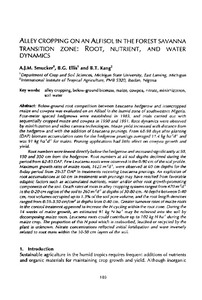| dc.contributor.author | Smucker, A.J. |
| dc.contributor.author | Ellis, B.G. |
| dc.contributor.author | Kang, B. |
| dc.date.accessioned | 2019-12-04T11:24:54Z |
| dc.date.available | 2019-12-04T11:24:54Z |
| dc.date.issued | 1995 |
| dc.identifier.citation | Smucker, A.J., Ellis, B.G. & Kang, B. (1995). Alley cropping on an Alfisol in the forest savanna transition zone: root, nutrient, and water dynamics, Alley farming research and development: Conference Proceedings of an International Conference on alley farming, Ibadan, Nigeria, 14-18 September, 1992. Ibadan, Nigeria: IITA, (p. 103-121). |
| dc.identifier.uri | https://hdl.handle.net/20.500.12478/4485 |
| dc.description.abstract | Below-ground root competition between Leucaena hedgerow and intercropped maize and cowpea was evaluated on an Alfisol in the humid zone of southwestern Nigeria. Four-meter spaced hedgerows were established in 1983, and trials carried out with sequentially cropped maize and cowpea in 1990 and 1991. Root dynamics were observed by minirhizotron and video camera technologies. Maize yield increased with distance from the hedgerow and with the addition of Leucaena prunings. From 68-98 days after planting (DAP) biomass accumulation rates for the hedgerow prunings averaged 11.4 kg ha-1 d-1 and was 91 kg h-1 d-1 for maize. Pruning applications had little effect on cowpea growth and yield. Root numbers were fewest directly below the hedgerow and increased significantly at 50, 150 and 350 cm from the hedgerow. Root numbers at all soil depths declined during the period from 62-83 DAP. Few Leucaena roots were observed in the 0-90 cm of the soil profile. Maximum growth rates of maize roots, 1625 m2 d1, were observed at 60 cm depths for the 8-day period from 29-37 DAP In treatments receiving Leucaena prunings. An explosion of root accumulations at 60 cm in treatments with prunings may have resulted from favorable edaphic factors such as accumulated nutrients, water and/or other root growth. Promoting components 01 the soil. Death rates of roots in alley cropping systems ranged from 470 m-2 d-1 in the 0-20 cm region of the soil to 260 m-2 d-1 at depths of 30-80 cm. At depths between 0-40 cm, root volumes occupied up to 1.3% of the soil pore volume, and the root length densities ranged from 0.59-3.50 cm/cm3 al depths from 0-40 cm. Greater turnover rates of maize roots in the control treatment appeared 10 increase the N cycling within the root zone. During the 14 weeks of maize growth, an estimated 91 kg N ha-1 may be released into the soil by decomposing maize roots. Leucaena roots could contribute up to 102 kg N ha-1 during the maize crop. The proportion of this N pool which is reabsorbed, leached or recycled by the plants unknown. Nitrate concentrations reflected initial fertilization and were inversely related 10 root mass within the 10-50 cm layers of the soil. |
| dc.language.iso | en |
| dc.subject | Alley Cropping |
| dc.subject | Ground |
| dc.subject | Biomass |
| dc.subject | Maize |
| dc.subject | Cowpeas |
| dc.subject | Nitrate |
| dc.subject | Minirhizotron |
| dc.subject | Soil Water |
| dc.title | Alley cropping on an Alfisol in the forest savanna transition zone: root, nutrient, and water dynamics |
| dc.type | Conference Paper |
| cg.contributor.affiliation | Michigan State University |
| cg.contributor.affiliation | International Institute of Tropical Agriculture |
| cg.coverage.region | Africa |
| cg.coverage.region | West Africa |
| cg.coverage.country | Nigeria |
| cg.authorship.types | CGIAR and advanced research institute |
| cg.iitasubject | Maize |
| cg.iitasubject | Crop Systems |
| cg.iitasubject | Nutrition |
| cg.iitasubject | Cowpea |
| cg.iitasubject | Soil Health |
| cg.iitasubject | Forestry |
| cg.accessibilitystatus | Limited Access |
| local.dspaceid | 100735 |

